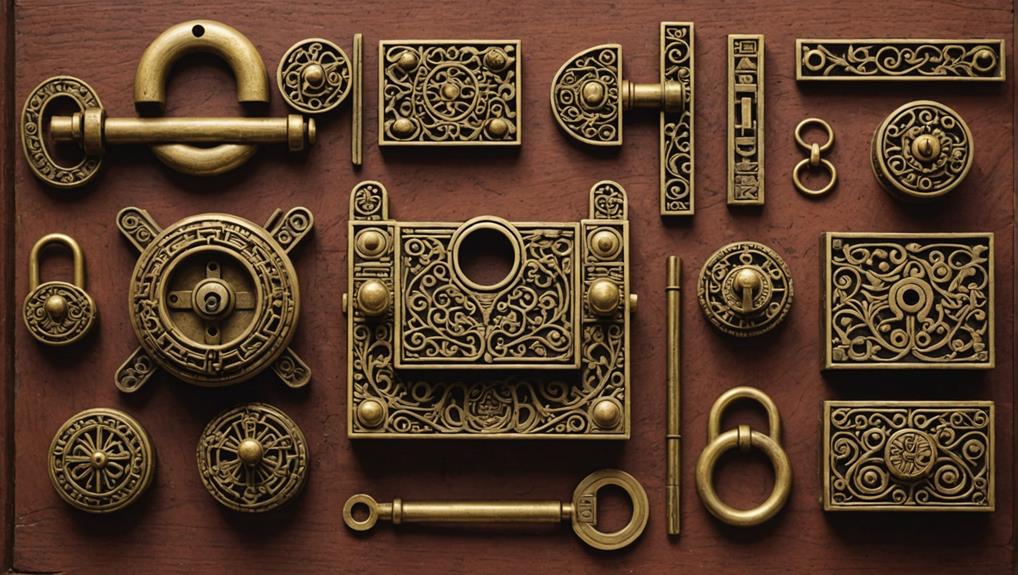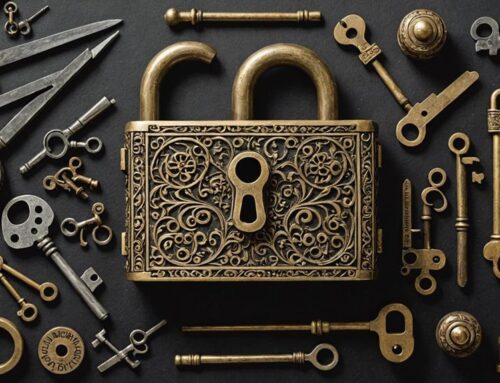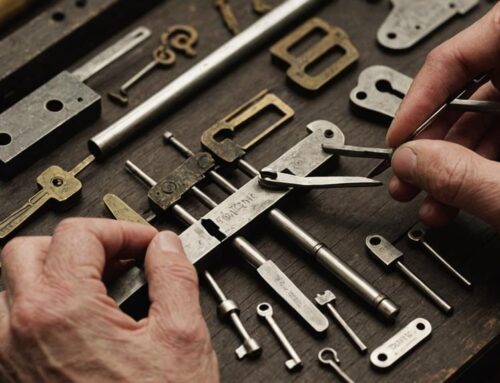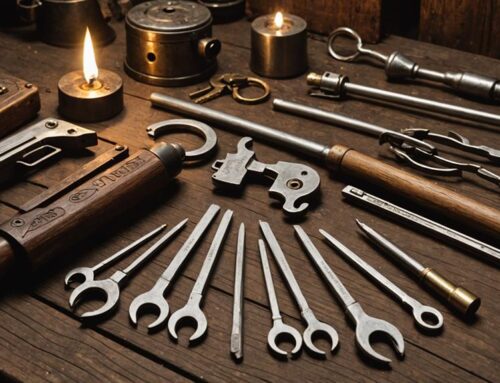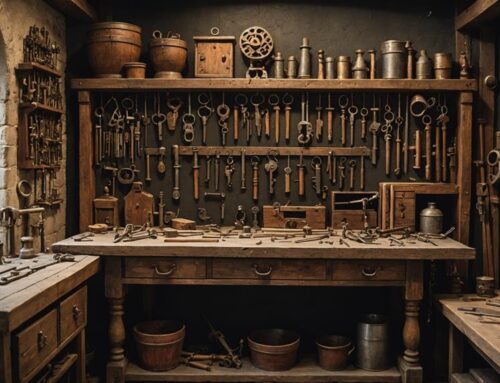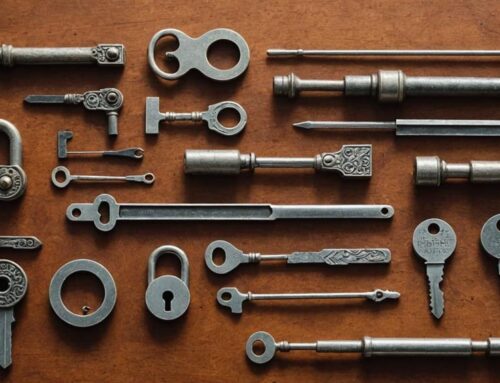Reveal the fascinating world of ancient lock mechanisms by exploring the top 10 techniques used by civilizations to safeguard their valuables. From Ancient Egyptians' wooden pin locks to Romans' intricate key-operated mechanisms, each technique showcases historical ingenuity. Discover the evolution of locks through different eras, materials employed, and key components essential for secure operation. Immerse yourself in the mechanical intricacies behind key shapes, lock picking methods, and security strengths of various ancient lock types. Each technique reveals a unique aspect of ancient craftsmanship and the importance of security in past societies, providing valuable insights into the evolution of lock technology.
Key Takeaways
- Ancient lock mechanisms include wooden pin locks, key-operated locks, lever tumbler locks, warded locks, and electronic/smart locks.
- Key components consist of keys, bolts, wards, springs, and levers for lock operation and security.
- Lock picking techniques involve pin tumblers, serpentine key devices, shear lines, keyways, tension, and feedback for manipulation.
- Materials like iron, bronze, brass, wood, and animal bones were used in ancient lock construction for durability and security.
- Key shape and function are crucial, with intricate patterns and ridges matching lock components for access control.
Historical Overview
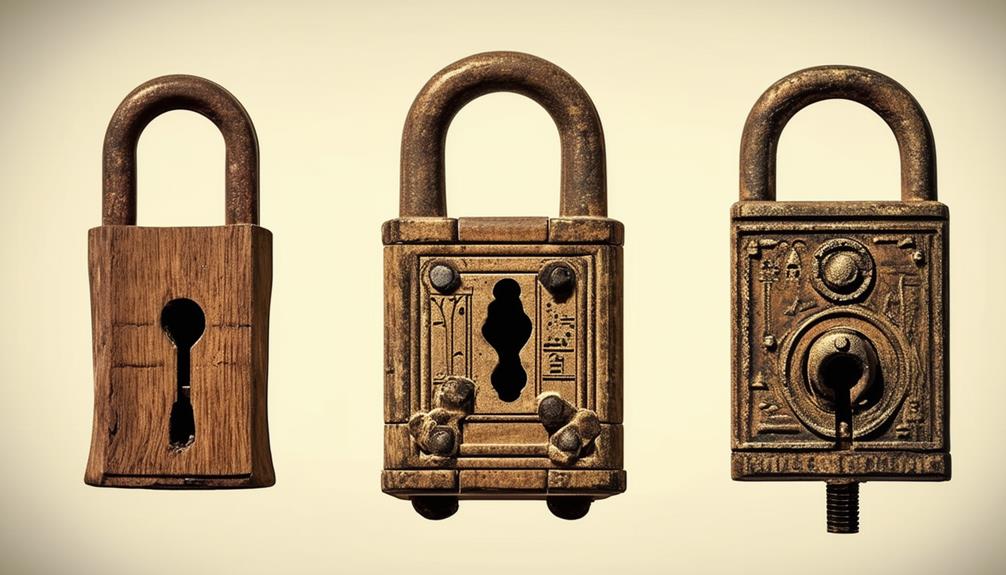
If you ever wondered how ancient civilizations secured their valuables, a glimpse into the historical overview of lock mechanisms can provide fascinating insights.
Historical lock mechanisms have been essential in protecting treasures and important documents throughout history, laying the groundwork for what would eventually evolve into modern security solutions.
In ancient Egypt, for example, wooden pin locks were commonly used. These locks consisted of a bolt that slid into a slot in the door frame, secured by pins made of wood.
Moving forward to ancient Rome, key-operated locks were developed using intricate designs to guarantee security, reflecting the early stages of the evolution of lock security. The Romans also introduced ward locks, which utilized obstructions or wards inside the lock to prevent unauthorized access.
During the Middle Ages, locksmiths in Europe crafted sophisticated lever tumbler locks, employing levers of varying lengths to prevent the bolt from moving.
Understanding the evolution of historical lock mechanisms provides valuable insight into the ingenuity and craftsmanship of ancient civilizations in safeguarding their valuables.
Key Components Analysis
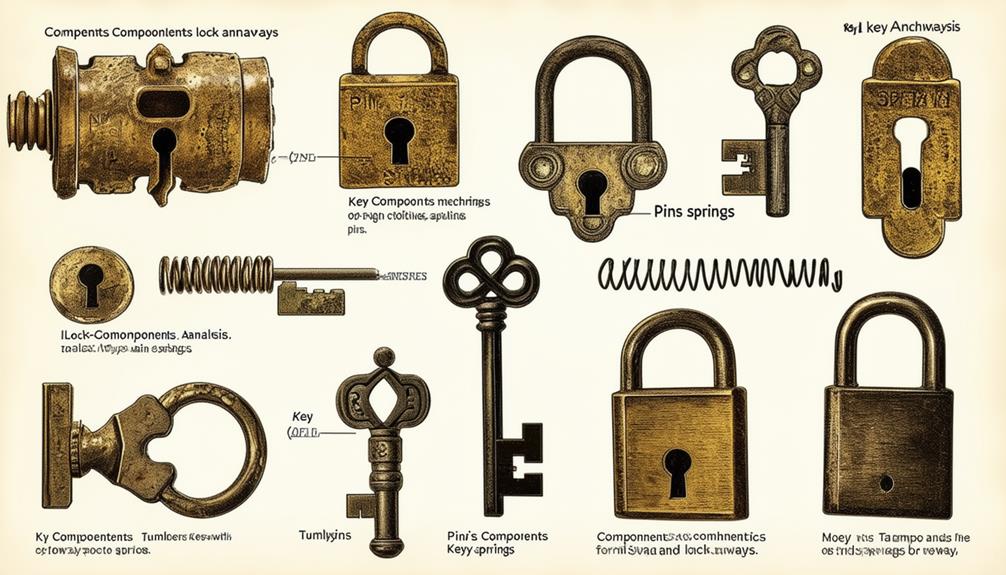
Exploring the inner workings of ancient lock mechanisms reveals key components that were essential to their functionality and security. Understanding these components provides insight into the ingenious design of ancient locks, which have evolved markedly over time, showcasing the creativity of early civilizations in enhancing security.
Here are the key components that played an important role in the operation of ancient lock mechanisms:
- Key: The unique shape and configuration of the key were designed to align perfectly with the internal components of the lock, enabling it to turn and open the mechanism. This careful design reflects the evolution of lock picking techniques that paralleled advancements in lock design.
- Bolt: This solid metal component would slide or move within the lock, securing the door or chest when in a locked position.
- Wards: These protrusions inside the lock chamber interacted with the key to allow or prevent movement of the bolt, adding an extra layer of security.
- Springs: These components exerted pressure on the bolt or levers, ensuring they returned to their default positions after the key was turned.
- Levers: Found in more complex ancient lock mechanisms, levers needed to be lifted to specific heights by the key to align the internal components and release the bolt.
Reverse Engineering Approach
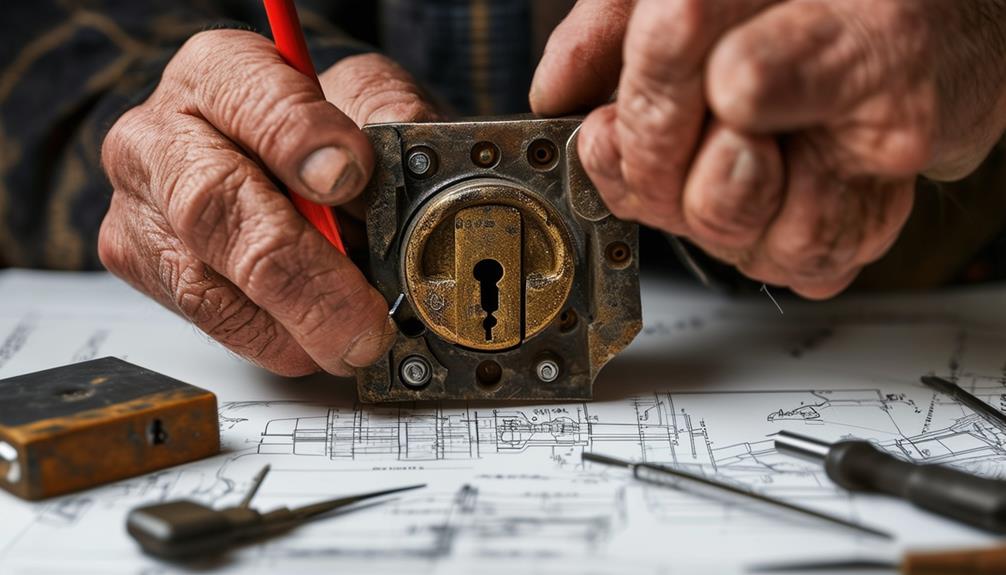
Delving into ancient lock mechanisms through a reverse engineering approach allows for a deeper understanding of their intricate design and functionality. By dismantling and studying these ancient lock mechanisms, you can gain valuable insights into how they were constructed and operated.
This practice not only reveals the craftsmanship behind each lock but also highlights the historical context in which these mechanisms were developed, showcasing the evolution of security technology from simple devices to more complex systems the evolution of lock picking.
Through reverse engineering, you can trace the evolution of these ancient lock mechanisms and uncover the ingenious methods used by ancient locksmiths to secure valuables.
This approach involves carefully disassembling the lock, analyzing each component, and deciphering how they work together to provide security.
By reverse engineering ancient lock mechanisms, you can appreciate the craftsmanship and engineering skills of past civilizations. Understanding the inner workings of these locks can also provide clues about the technological advancements of the time and the level of sophistication achieved in creating secure mechanisms.
Through this method, you can reveal the secrets of ancient lock mechanisms and appreciate the ingenuity behind their design.
Material Composition Examination
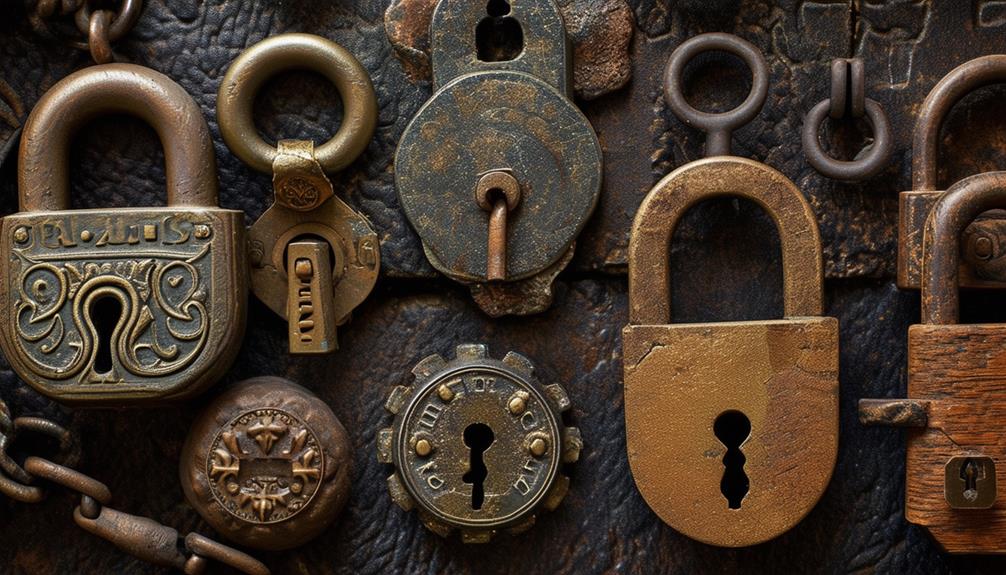
Analyzing the material composition of ancient lock mechanisms is essential in understanding their durability and security features.
When delving into the material composition examination of these intricate security devices, consider the following points:
- Metals Used: Ancient lock mechanisms often employed a variety of metals such as iron, bronze, or brass, each offering different levels of strength and resistance to wear. The choice of metal often reflected the technological advancements and available resources of the time, with medieval locksmith tools and techniques influencing design choices.
- Organic Materials: Some ancient locks incorporated organic materials like wood or animal bones, showcasing the resourcefulness of ancient craftsmen.
- Corrosion Resistance: Understanding how well the materials resist corrosion provides insights into the longevity of these locks.
- Impact Resistance: The ability of the materials to withstand external forces without breaking is vital for the functionality of ancient lock mechanisms.
- Malleability: Examining the malleability of the materials used can shed light on the intricate designs achievable in ancient lock mechanisms.
Key Shape and Function Study
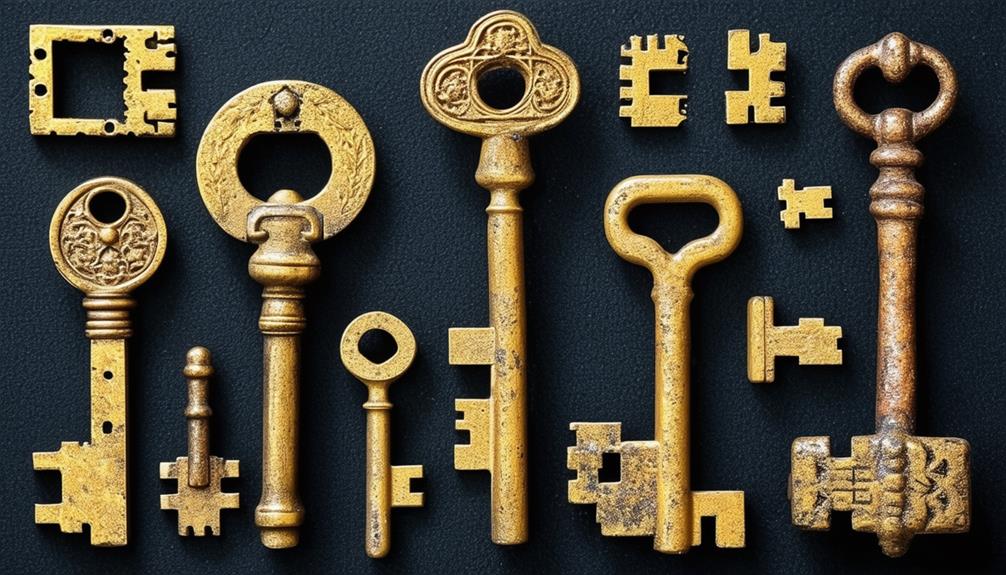
The study of key shape and function in ancient lock mechanisms provides valuable insights into the intricate design and operational mechanics of these security devices. In ancient times, keys were crafted to fit specific locks, with unique shapes and mechanisms that guaranteed only the rightful owner could gain access.
The key's design was vital in aligning internal components within the lock to allow it to be turned and the bolt to be released. As explored in historical lock picking techniques, understanding the relationship between key shape and lock mechanism is fundamental for appreciating the complexity and security measures employed by ancient civilizations to protect their valuable possessions.
Ancient lock mechanisms often featured keys with intricate patterns, varying ridges, and notches that matched corresponding components inside the lock. The precise craftsmanship required in creating these keys highlights the importance placed on security in earlier societies.
Lock Picking Techniques
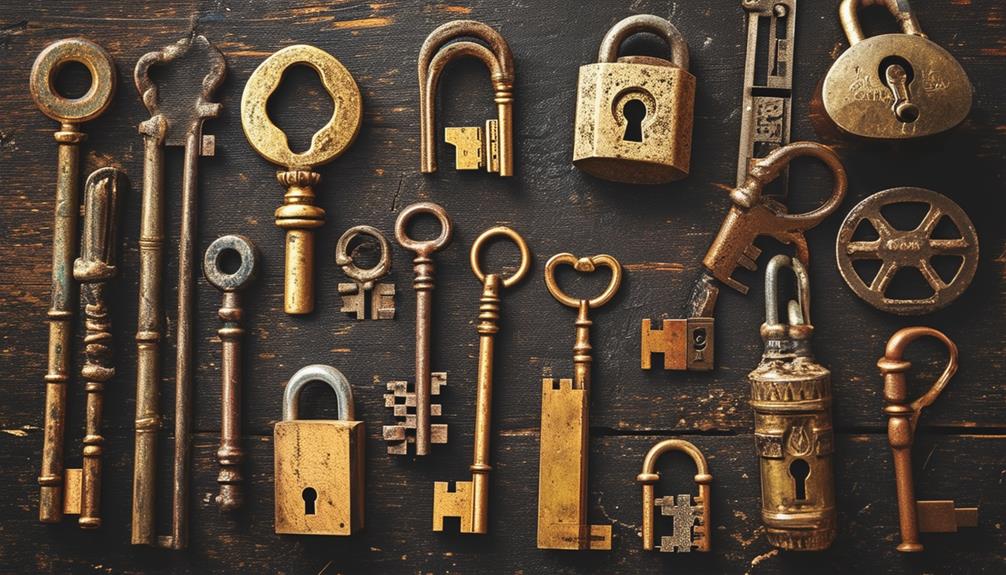
Now, let's talk about the fascinating world of lock picking techniques.
Traditional pin tumblers and serpentine key devices are among the clever mechanisms used by ancient locksmiths to secure their treasures.
Many of these historical methods, such as the use of warded locks, showcase the intricate artistry involved in their design and function.
Understanding these techniques offers insight into the craftsmanship and ingenuity of the locks of the past, providing a glimpse into mastering historic lock-picking techniques.
Traditional Pin Tumblers
Traditional pin tumbler locks are one of the most common types of locks used today. These locks have been around for centuries and are based on simple yet effective principles.
When it comes to understanding how traditional pin tumbler locks work, here are some key points to take into account:
- Pin Stacks: The pins in a traditional pin tumbler lock are stacked in a series of driver pins and key pins that align when the correct key is inserted.
- Shear Line: The point at which the key pins and driver pins meet is known as the shear line, allowing the lock to turn when the pins are aligned.
- Keyway: The unique shape of the keyway corresponds to the specific key that fits into the lock and lifts the pins to the correct height.
- Tension: Applying the right amount of tension to the lock is essential in manipulating the pins to the shear line for successful picking.
- Feedback: Picking a pin tumbler lock requires a keen sense of feedback from the lock to determine when each pin is set correctly.
Serpentine Key Devices
How can lock pickers manipulate traditional pin tumbler locks more effectively?
When it comes to ancient lock mechanisms, understanding the use of serpentine key devices can provide valuable insights into lock picking techniques.
Serpentine key devices are tools that mimic the shape and functionality of a traditional key, allowing lock pickers to manipulate the pins inside the lock to open it without the original key. By using a serpentine key device, lock pickers can apply tension to the lock cylinder while lifting the pins to the correct height, enabling them to bypass the locking mechanism.
These devices are especially useful for opening pin tumbler locks, where a series of pins must be lifted to specific heights to align with the shear line.
By mastering the manipulation of serpentine key devices, lock pickers can improve their efficiency in opening traditional locks based on ancient mechanisms.
Practicing with these tools can enhance your understanding of lock picking techniques and help you develop the skills needed to overcome various security measures.
Understanding Ancient Key Designs
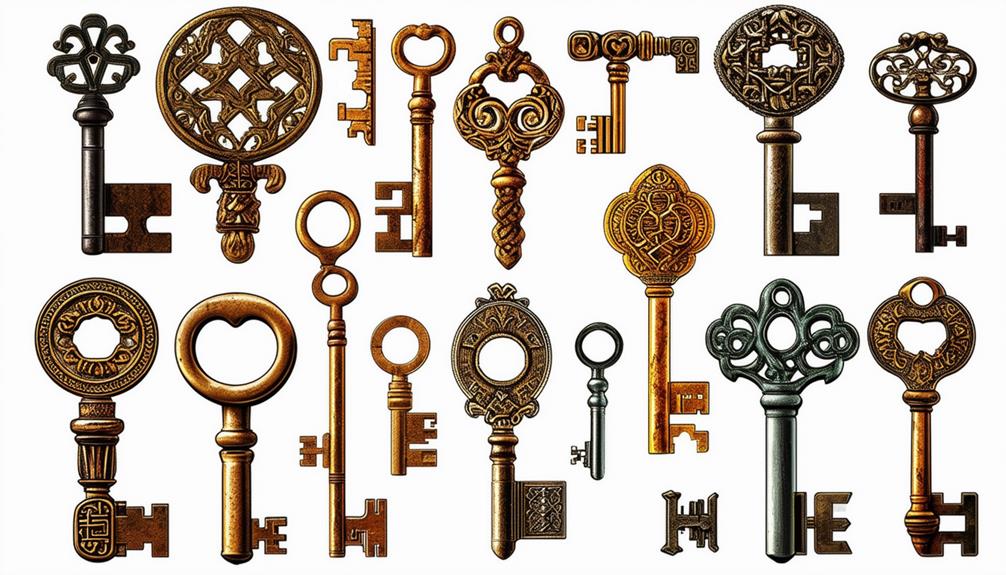
Throughout history, key designs have played a crucial role in securing valuable possessions and safeguarding important spaces. Ancient key designs weren't only functional but also intricate works of art, reflecting the craftsmanship and innovation of their time.
The development of pin tumbler lock technology showcases how ancient mechanisms influenced modern security systems. Understanding the evolution of these ancient key designs can provide insight into the development of lock mechanisms and security measures used in different civilizations.
- Egyptian Key Designs: Hieroglyphic inscriptions often adorned keys, showcasing the importance of the object they secured.
- Roman Key Designs: Roman keys featured intricate patterns and were often made of bronze or iron for durability.
- Chinese Key Designs: Ancient Chinese keys were shaped like rings and were symbols of power and authority.
- Greek Key Designs: Greek keys were simple yet effective, with some keys featuring unique shapes for specific locks.
- Viking Key Designs: Viking keys were robust and often double-edged, showcasing the Norse craftsmanship and practicality.
Mechanical Operation Deconstruction

Now, let's break down the intricate workings of ancient lock mechanisms.
You can start by analyzing the keyhole mechanism, which is designed to precisely fit the shape of the key, ensuring a secure connection.
Understanding how it interacts with the key reveals insights into the craftsmanship of medieval locksmiths, who often employed techniques such as the art of medieval locksmithing to enhance security.
Then, explore the pin tumbler system, which plays an essential role in securing the lock.
Keyhole Mechanism Analysis
Exploring the keyhole mechanism reveals a fascinating interplay of components that work together seamlessly to secure and release the lock.
The ancient lock mechanisms were ingeniously designed to provide security through intricate mechanisms.
Here's a breakdown of the keyhole mechanism:
- Keyway: The keyway is the slot where the key is inserted, aligning with the internal components.
- Warded Plates: These plates inside the keyhole prevent the use of incorrect keys, ensuring only the correct key can operate the lock.
- Spring-Loaded Pins: These pins interact with the notches on the key, allowing for the rotation of the lock mechanism.
- Rotating Cam: The cam is rotated by the key, disengaging the lock's bolt or latch to open the lock.
- Bolt or Latch: The final component that secures or releases the lock, operated by the rotation of the cam.
Understanding the keyhole mechanism provides insight into the sophisticated engineering of ancient lock mechanisms, showcasing the craftsmanship of the past.
Pin Tumbler Breakdown
Taking a closer look at the mechanics of ancient locks, the pin tumbler breakdown reveals a fundamental aspect of lock operation.
In medieval lock mechanisms, the pin tumbler system consists of a series of pins of varying lengths within the lock cylinder. When the correct key is inserted into the keyway, it lifts these pins to specific heights, aligning them along what's known as the shear line. This alignment allows the plug to rotate freely within the lock, releasing it.
Understanding this breakdown is essential because it illustrates how the proper key manipulates the pins to create the necessary alignment for the lock to open. If the key is incorrect or poorly made, the pins won't align correctly, preventing the plug from turning and the lock from opening.
This simple yet ingenious mechanism has stood the test of time and is still utilized in modern pin tumbler locks, showcasing the enduring effectiveness of medieval lock mechanisms.
Tracing Lock Evolution
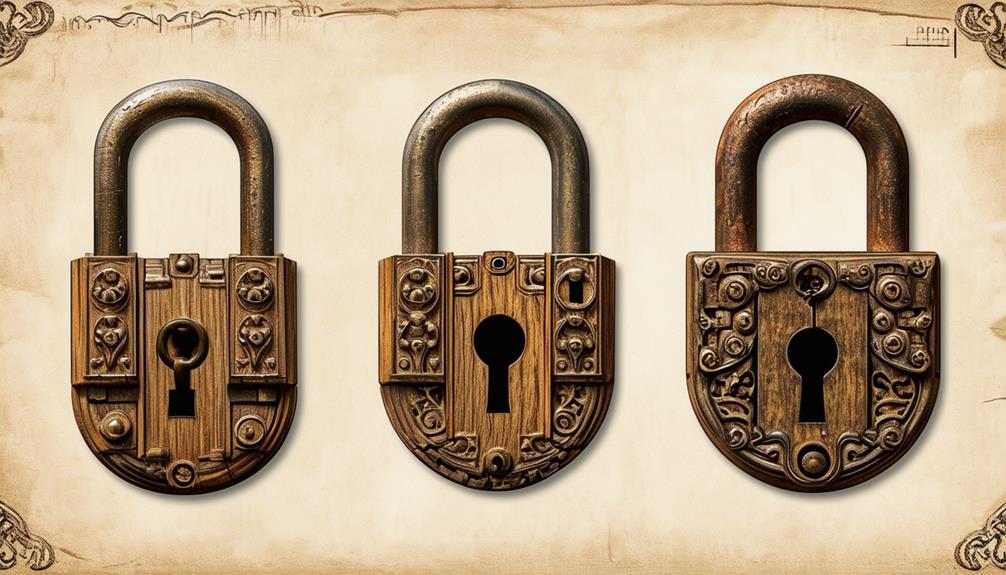
Tracing the evolution of locks provides valuable insights into the development of security systems throughout history. Understanding how ancient lock mechanisms have transformed over time can shed light on the ingenuity and advancements made in safeguarding valuables.
High-security locks, which utilize advanced technology and robust materials, represent a significant leap from earlier designs that primarily relied on basic mechanisms for protection. The concept of complex keyways, making unauthorized duplication nearly impossible, can be traced back to the innovations that evolved throughout history, highlighting the ongoing quest for security in high-security locks.
- Early Locks: Ancient civilizations like the Egyptians and Greeks utilized wooden pin locks for basic security.
- Roman Innovations: Romans introduced metal locks with intricate key mechanisms, enhancing security measures.
- Medieval Advancements: During the Middle Ages, the development of warded locks added layers of complexity to key-operated systems.
- Industrial Revolution Impact: The Industrial Revolution saw the mass production of lever tumbler locks, making them more accessible.
- Modern Technologies: Contemporary lock evolution involves electronic and smart locks, integrating technology for enhanced security features.
Comparative Analysis of Lock Types
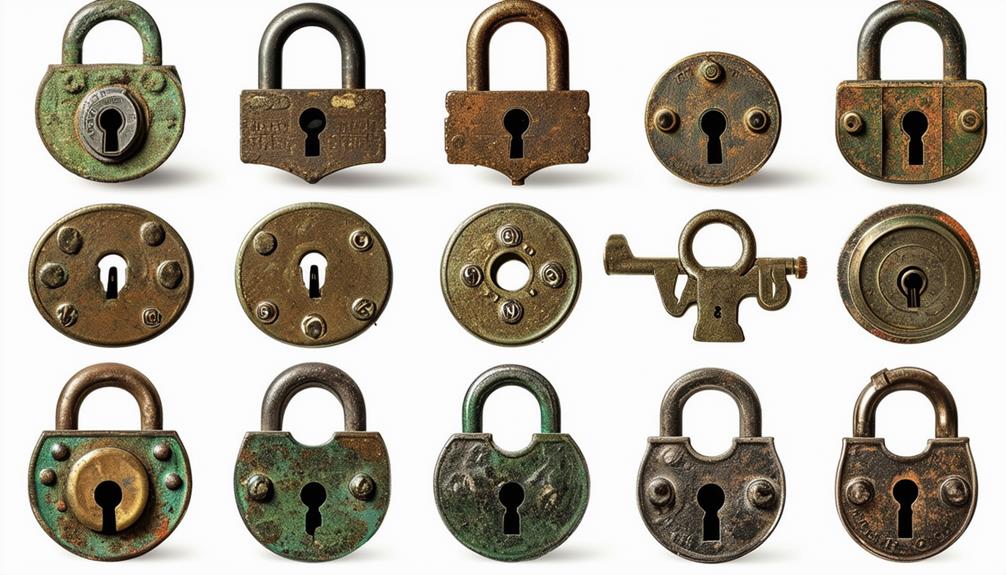
Let's compare and contrast various lock types to understand how they've evolved over time.
From simple wooden pins in ancient Egypt to the intricate designs of modern electronic locks, each advancement has contributed to increasing security measures.
By examining the security strengths of different locks, we can gain insight into the effectiveness of ancient lock mechanisms.
This comparative analysis will shed light on the advancements made in lock technology and the level of security they provided in ancient times, reflecting the evolution of lock security through the ages.
Lock Evolution Overview
A thorough examination of the evolution of lock mechanisms reveals a fascinating array of designs and innovations that have contributed to the security systems we use today.
From the earliest ancient lock mechanisms to the sophisticated systems of the modern era, locks have undergone significant developments over the centuries.
Here is an overview of the key stages in the evolution of lock technology:
- Simple Wooden Pin Locks: Early locks consisted of wooden pins that prevented the bolt from being moved.
- Egyptian Pin Tumbler Locks: Ancient Egyptian locks featured pins of varying lengths that had to be lifted to specific heights to release.
- Roman Combination Locks: Romans introduced the concept of combination locks, where a series of rotations in the correct order would engage the mechanism.
- Medieval Key-Operated Locks: The Middle Ages saw the rise of key-operated locks with intricate designs for added security.
- Industrial Revolution Innovations: Advancements during the Industrial Revolution led to the mass production of locks, making them more accessible.
Security Strength Comparison
As we explore deeper into the domain of lock mechanisms, it becomes imperative to evaluate the varying levels of security offered by different lock types. When comparing the security strength of ancient lock mechanisms, it's essential to regard factors such as design complexity, materials used, and susceptibility to picking or other forms of manipulation.
Ancient lock mechanisms varied in their security levels. For instance, the ancient Egyptian pin tumbler locks were quite sophisticated for their time, offering decent security by requiring the correct alignment of pins to open.
In comparison, the Roman lock designs, while innovative, were less secure due to simpler mechanisms that could be bypassed with basic tools.
On the other hand, the Chinese lock mechanisms, such as the intricate combination locks, provided high security by incorporating complex internal mechanisms that required precise manipulation to open.
These ancient examples highlight the diverse approaches to security in lock design throughout history, showcasing both strengths and vulnerabilities in ancient lock mechanisms. Understanding these differences can offer valuable insights into the evolution of lock security.
Frequently Asked Questions
Can Modern Lock Technology Be Traced Back to Ancient Techniques?
Yes, modern lock technology can indeed be traced back to ancient techniques.
The fundamental principles of securing doors and valuables have evolved over centuries, with many innovative ideas originating from ancient civilizations.
By studying the historical development of lock mechanisms, you can gain a deeper appreciation for the ingenuity and creativity that has shaped the locks we use today.
Learn how ancient techniques laid the foundation for modern security systems.
How Did Ancient Locksmiths Protect Their Trade Secrets?
To safeguard their trade secrets, ancient locksmiths employed a variety of techniques. They often worked in secrecy, conducting their craft behind closed doors.
Locksmiths also utilized special tools and devices to prevent others from observing their methods. Additionally, they may have passed down knowledge only to trusted apprentices, ensuring that their techniques remained exclusive.
Were Ancient Locks Susceptible to Environmental Damage?
Ancient locks were susceptible to environmental damage due to their materials and exposure. Rust, corrosion, and wear from weather conditions could weaken the mechanisms over time.
Locksmiths often had to develop techniques to protect their creations from these elements. Understanding how environmental factors affected the locks was essential in maintaining their functionality and longevity.
It required constant vigilance and innovation to guarantee the security of these ancient mechanisms.
What Cultural Influences Shaped Ancient Lock Designs?
Cultural influences were pivotal in shaping ancient lock designs, reflecting the unique traditions and values of each society.
Techniques like intricate carvings, symbols, and materials used were all influenced by the beliefs and practices of the time.
Through these designs, ancient civilizations not only secured their possessions but also expressed their cultural identity.
Understanding the historical context behind these locks provides insight into the fascinating blend of artistry and functionality in ancient security systems.
Did Ancient Civilizations Have Specialized Locksmith Guilds?
Ancient civilizations had specialized locksmith guilds that played an essential role in developing sophisticated lock mechanisms.
Members of these guilds dedicated themselves to mastering the craft of locksmithing, passing down their knowledge through generations.
These skilled artisans were highly respected for their ability to create intricate and secure locks, often tailored to the specific needs of their communities.
Their expertise guaranteed the protection of valuable belongings and safeguarded important spaces.
Conclusion
So there you have it – by delving into the history and mechanics of ancient lock mechanisms, you can gain a deeper appreciation for the ingenuity of our ancestors. Did you know that the oldest known lock dates back to over 4,000 years ago in ancient Egypt? Keep exploring the fascinating world of ancient locks and reveal the secrets of the past!

